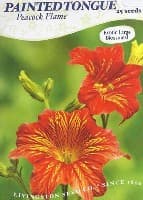How to Grow Painted Tongue

Growing Painted Tongue Flowers in Your Home Garden
Painted Tongue flowers are a hardy annual flower plant, that grows best in cool weather. They will grow best in spring and fall, and slowly in hot summer months. Plants are native to Chile in South America. When growing Painted Tongue flowers, make sure you know the variety. Plant taller varieties in the back of the flower garden. And, plant dwarf varieties in the front of the garden. Painted Tongue seeds have a long period of germination. So, mark the planting location when sowing directly into the flower garden.
Painted Tongue plants have lance-shaped leaves. It has five-lobed, cornet-shaped flowers. The flowers come in several vibrant colors that look great on a patio or deck. Cooler weather will prolong blooms.
Did You Know? Painted Tongue is a member of the Solanaceae family. This includes petunias, peppers, and tomatoes.
Painted Tongue Flower Plant Specifications
Flower colors: Colors include cream, crimson, deep blue, deep red, mahogany, orange, violet, deep blue, crimson, and yellow.
Flowers Bloom: Spring thru mid-summer, and again in Fall
Plant Height: 1 to 3 feet. Dwarf varieties grow just 18 to 24 inches.
Ideal Soil pH: 6.6 – 7.3.
Light Requirement: Full sunlight to partial shade.
Hardiness Zones: 9 – 12
Are Plants Toxic? No.
Deer Resistant? Yes, the plants are resistant to deer and rabbits.
Native To: Chile and several other countries in South America.
Plant Type: Annual
Botanical Name: Salpiglossis sunuata
Other Names: Peacock Flame, Stained Glass Flower, Velvet Trumpet Flower, Scalloped Tube Tongue
Are Painted Tongue Flowers Edible?
NO!!
These plants are not considered toxic to humans or pets. However, there is no information to suggest that they are edible. We suspect they do not taste good. So, we recommend you do not eat them.
Medicinal Uses for Painted Tongue Flowers
There are no known medicinal applications for Painted Tongue plants.
Light Requirements
Grow Painted Tongue plants in bright, direct, full sun. Select a planting location where they will receive six to eight hours of full sunlight.
The plants grow in partial sunlight. And, in warmer regions, this cool-weather plant benefits from shade in the mid-afternoon. However, if they do not receive sufficient sunlight, the plant can grow lanky and will produce fewer blooms.
Annual Painted Tongue Plant Propagation
Painted Tongue seeds can be difficult to germinate. We recommend an indoor start.
Sow Painted Tongue seeds indoors four to six weeks before the last frost. We highly recommend a heated germination mat. It increases the speed of germination, and for a higher germination rate.
Plants can also be started directly into your flower bed. Sow seeds after the last frost when the soil begins to warm.
Garden Tip: Seeds need consistent moisture to germinate.
Painted Tongue Seeds Days to Germination: 14 – 21, normally. It can take up to 30 days. If you directly sow the seeds into the planting site, mark the area.
How to Grow Annual Painted Tongue Flower Plants
Grow this plant in cooler climates, It will not grow well in hot, humid southerly areas of the country.
Plants grow best in full sun to light shade.
Painted Tongue will grow in average soils. However, the soil should be well-drained.
Plants do not need a lot of fertilizer. For average soils, apply light applications every 4-6 weeks.
Water plants during dry spells, and especially in hot weather.
After the plants have grown several inches tall, pinch off the growing tip. This promotes new stems, resulting in a bushier growth.
Mulch around plants to keep weeds down, and to retain soil moisture.
Pinch back growing tips when the plant is young. This promotes a bushier plant.
Provide support for the stems of taller varieties. High winds can knock them over.
How to Grow Painted Tongue Plants in Containers and Flowerpots
Dwarf varieties of Painted Tongue flowers look great grown in containers or flowerpots on your balcony or deck. You can grow taller varieties in a container, too. However, you need a large container and just the right location.
In addition to the normal steps for growing them, here’s how to care for them in a flowerpot or container:
- It is important to have a drain hole to allow excess water to drain from the pot.
- Keep an eye on the moisture level. Check the plants every day or two, especially in extended periods of hot, dry weather.
- Keep the soil moist, but not wet. It is okay to let the top of the soil begin to dry between watering.
- When watering the plants, thoroughly wet the soil. Excess water will drain through the hole in the bottom of the flowerpot.
- Nutrients in a flowerpot are limited. So, use fertilizer spikes to feed the plants. Or, apply a light solution of liquid fertilizer once a month.
- Select a sunny to partly sunny location on your deck.
Pruning Painted Tongue Plants
During the course of the growing season, remove any dead, damaged, or diseased leaves and stems. This will make the plant more attractive and improve plant health.
Pinch back the growing tips of the plant. This promotes new stem and leaf growth, resulting in a bushier appearance.
As the flowers die off, deadhead the spent blooms. If the season is long enough in your area, new buds will appear.
Insects and Plant Disease
Aphids can be occasional problems. Disease problems are uncommon.
If insect or disease problems occur, treat the problem early with organic or chemical insect repellents and fungicides.
Also see: Plant Problems – Identify the causes and find the cures.
Related Articles
Also, people who read this article on Painted Tongue flowers will like:
Plant Problems – Identify the causes and find the cures.
Please support our site. Shop for:
- rmmatthews100@hotmail.com
- 585-721-6528
- Rochester, NY
©1999-2024 GardenersNet.Com, All Rights Reserved

